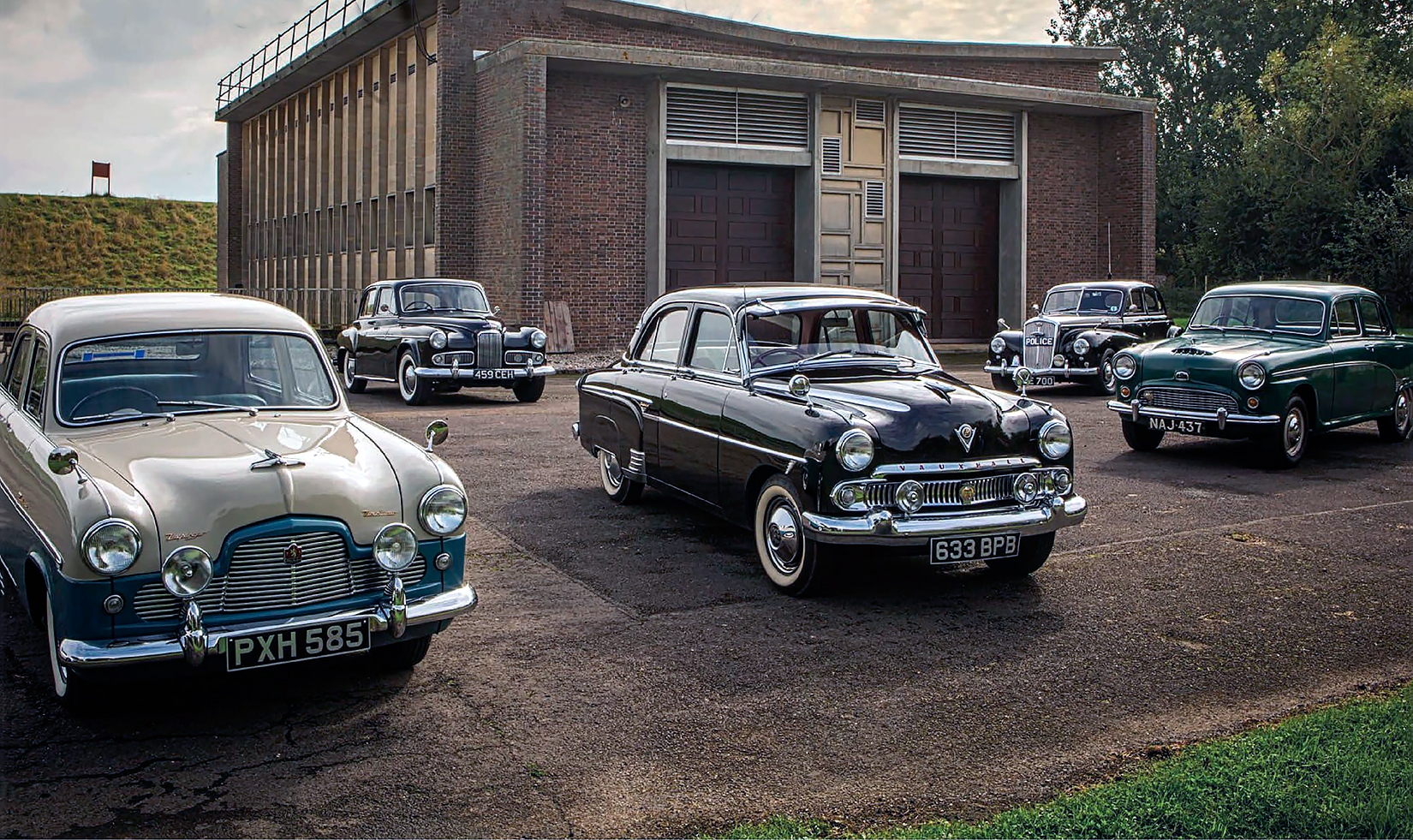
Old-school values in a new world. Best of the ’50s saloons Zephyr meets its rivals. 1950s Bargefest Ford takes on rivals from Vauxhall, Humber, Austin and Wolseley. These big saloons were objects of desire when rationing was making way for rock ’n’ roll. Martin Buckley indulges in a bargefest, 1950s style. Photography Tony Baker. Battle of the Barges, part four: Buckley heads back to the ’50s.
style=”flat” size=”4″]With WW2 still fresh in everyone’s memory, and 14 years of rationing not long ended, the cars you see here were the domestic barges of the mid-1950s that most people could only dream of. They offered six-cylinder refinement, modern full-width styling and amenities that bordered on the decadent.
We tend to think of this generation of massmarket ‘status saloons’ in terms of their wideboy owners of later decades – Michael Caine’s Alfie drove an E-series Vauxhall in the eponymous 1966 film. But to muster the £800-1200 required to buy a new Ford Zephyr, Vauxhall Cresta, Austin A90 or Wolseley 6/80 made you a person of real financial substance 10 years earlier when these barges were in their pomp.
The teddy boys and chancers of early-to-mid- ’50s Britain might have dreamed of ‘courting’ on the expansive bench seats of these aspirational straight-six saloons, of luxuriating in their heaters and (optional) radio sets, but you had to be a bank manager, an accountant or perhaps the owner of a successful small business to actually buy one. An established professional man, in fact, with your courting days long behind you.
To own a £1500 Humber Super Snipe almost elevated you to the minor-tycoon league. This 4-litre behemoth is the sort of car you could equally well be chauffeured in as drive yourself, and in a way it puts our gathering slightly out of balance. On the other hand, the Super Snipe flies the flag for the Rootes Group and avoids us having to endure the miseries of its four-cylinder sister, the Hawk, because no true barge ever had fewer than six pistons. It also makes a neat link with the really heavyweight big saloons of prewar years and highlights the abilities of a new, lighter generation of short-stroke, unitaryconstruction family cars represented by the likes of the A90, Zephyr and Cresta.
It’s no surprise that the Ford and Vauxhall were the most successful models here, because at heart they are American – or at least created by applying American ideas of good engineering, simplicity and giving people what they wanted.
They were products of giant multi-national corporations that had the resources to carry out market research and design cars they knew the majority of customers would buy. Vehicles that were easy and pleasant to drive, tough and simple to look after (there were colonial sales to consider, after all) and modern to look at without offending contemporary British taste.
They were cars that were big enough to be impressive without looking out of place in the British landscape. They were lively and luxurious enough to make their owners feel that they’d got their money’s worth, yet with no particularly outstanding qualities that would mark them as enthusiasts’ cars – even if features such as overhead valves and independent front suspension were by no means universal at the time.
The Wolseley 6/80, meanwhile, has an appeal of its own, a conservative offering to the prewar- type motorist who clung to the values of that period but still wanted an authoritative saloon that spoke of his lofty social status. So, tear up your ration books, break out the Spam and splash out on a gallon or two of pool petrol as we explore the lost world of the early post-war British barge.
{CONTENTPOLL [“id”: 95]}
FORD ZEPHYR
style=”flat” size=”4″]These were the first monocoque Fords. They had relatively light, short-stroke, overhead-valve engines, innovative MacPherson strut front suspension and fully hydraulic brakes when such things were a big deal.
They were also the first large English Fords to be designed in-house at Dagenham, with an identity separate from the Dearborn-designed Pilot – the car the Zephyr, in effect, replaced. At just under £700, they offered refined up-to-the-minute motoring at reasonable cost.
What first strikes you about the Mk1 Zephyr is how small it is. Mike Chapman’s 43,000-mile nut-and-bolt-rebuilt example looks like a toy; this ‘big’ 1950s Ford is about the size of a Focus. It almost lacks the bulk to qualify as a true barge, in fact, yet there is room for five in its unadorned cabin comprising twin bench seats and that unyielding metal fascia. Such basic instruments and controls as it has are mostly grouped around the steering column in a cluster that is shaped like a sectioned flying saucer.
These cars were popular with tuners and had a very respectable competition pedigree. With its rare after-market ‘Ace Garage’ triple-SU set-up, the Zephyr sounds like a 1970s BMW as it whips up to 50mph in its useful second gear. It enjoys the sheer decadence of a cigar lighter, the glamour of a bonnet catch marked ‘HOOD’ and overdrive on top. When you drive it, you realise that it was meant for a generation of postwar owners who didn’t want to grind gears or heave on steering and brake pedals as they had in the days of the lumbering V8-Pilot.
The Ford is light and easy to drive with its three quiet ratios arranged so that you use them as little as possible, the gently understeering handling demanding as little skill as possible. It’s a neat, simple car cast in the mould of the 1949 American Fords, and its two-tone cream-and- blue paint scheme gives me a flashback to my first Ladybird books. The fact that Peter and Jane’s Dad had a MkI Zephyr seemed incredibly anachronistic even then. Indeed, by that time (the early 1970s) you rarely saw MkI Zephyrs, Zodiacs or Consuls on the road.
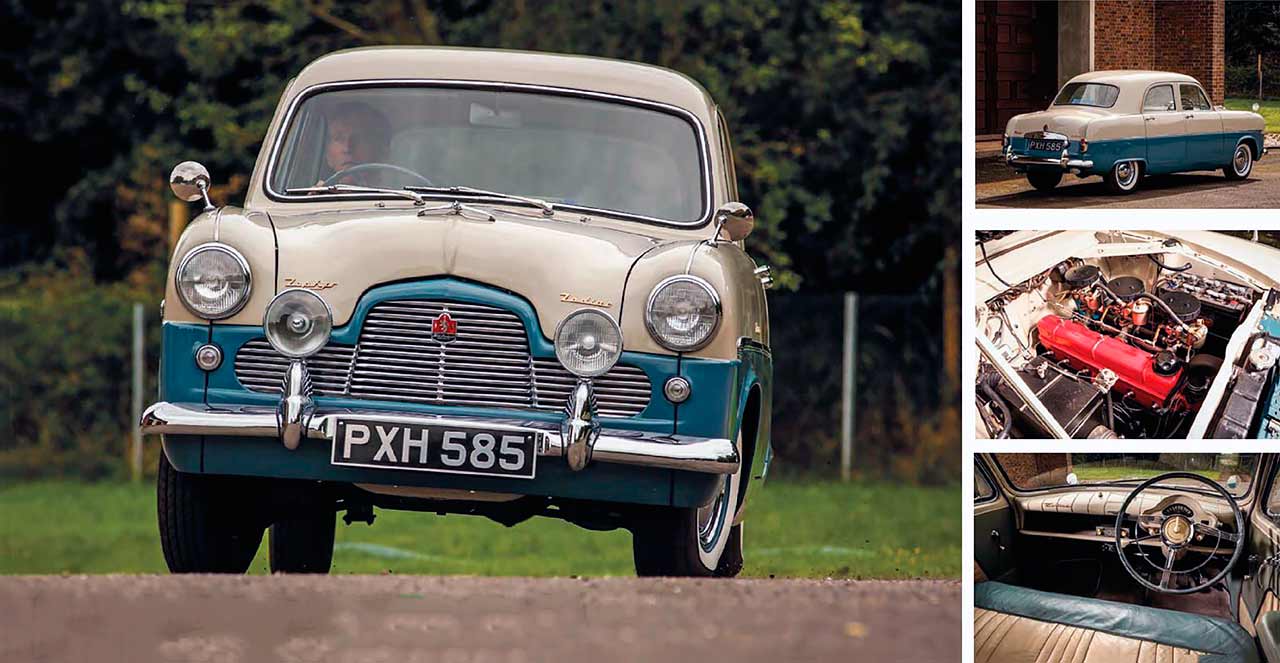
Clockwise, from main: two-tone paint lifts conservative styling; ‘six’ has been upgraded with triple SUs; compact dimensions clear from behind; austere interior.
‘IT ALMOST LACKS THE BULK TO QUALIFY AS A BARGE, YET THERE IS ROOM FOR FIVE’
TECHNICAL DATA FORD ZEPHYR
Sold/number built 1951-’1956/148,629
Construction steel monocoque
Engine all-iron, ohv 2262cc ‘six’, single carb;
Power and torque 68bhp @ 4000rpm; 112lb ft @ 2000rpm
Transmission three-speed manual o/d, RWD
Suspension: front MacPherson struts rear live axle, semi-elliptic leaf springs
Steering Burman worm and peg
Brakes drums
Length 14ft 2in (4318mm)
Width 5ft 4in (1626mm)
Height 5ft ¾ in (1543mm)
Weight 2618lb (1187kg)
0-60mph 21.1 secs
Top speed 81mph
Price new £684 (1953)
Now £8-15,000 (2017)
VAUXHALL CRESTA
style=”flat” size=”4″]The Vauxhall Cresta E-series went nose-to-nose with the Zodiac, the jazzier higher-compression sister to the Zephyr. Its 2.2-litre straight-six is even softer and smoother in character than the Ford engine, its over-square dimensions allowing greater revs and more power in a British motoring landscape that was at last free of the old RAC horsepower tax. Owned for 20 years by big Vauxhall enthusiast Steve Godden (by which I mean the cars are big, not him particularly), the Cresta has never been welded in its 61,000 miles and shares garage space with the later PA model that Godden and family tend to use for longer trips.
Although heavily influenced by the shapes of the first new post-war Chevrolets, the E-series cars were designed at Luton by Vauxhall’s David Jones. The shape arrived in 1951 and ran through to 1957, by which time the Wyvern (four cylinders) and the Velox (six cylinders) had been joined by the more luxurious Cresta. It boasted triple-tone paint, rear wheel spats and a lockable filler cap. Inside, there was a standard heater, clock and a choice of natty nylon trim (Elstrafab!) or, as in Godden’s car, leather.
As with the Ford, the unitary-body Cresta is relatively light. It’s also a consummate high-torque ‘top gear’ cruiser that rarely invites recourse to its wonderfully effortless threespeed column gearchange, which is by far the best of this collective bunch.
You loll around somewhat on the shapeless bench seat, hanging on to the big red steering wheel for support. Interestingly, the Cresta was said to have more urge through the gears than the 1949 3.8-litre Chevrolet that inspired it, yet the Vauxhall somehow lacks the charm of its period rival from Dagenham.
That said, you have to put its soft ride, its light, disengaged controls and its cheerful, chrome-encrusted detailing (the dashboard seems to talk the styling language of a kitchen appliance rather than a car) in the context of its time. This was a 1950s world where to own even a pre-war jalopy was a privilege, never mind this mid-Atlantic symbol of easy living.
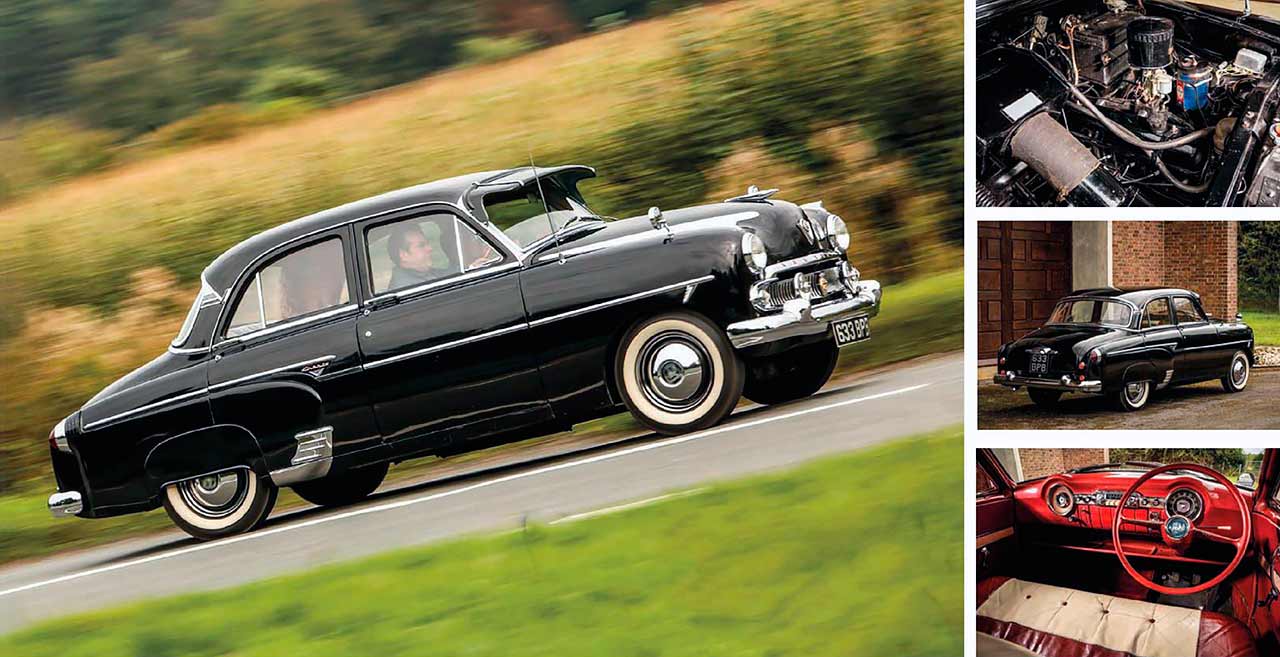
Clockwise, from main: styling is unmistakably transatlantic; big ‘six’ offers easy performance; plenty of chrome details; interior is even more extrovert than the body.
TECHNICAL DATA VAUXHALL CRESTA
Sold/number built 1954-’1957/166,504
Construction steel monocoque
Engine all-iron, ohv 2262cc ‘six’, Zenith carb;
Power and torque 67.5bhp @ 4000rpm; 103lb ft @ 1100rpm
Transmission three-speed manual, RWD
Suspension: front wishbones, coil springs rear live axle, semi-elliptic leaf springs
Steering Burman recirculating ball
Brakes drums
Length 14ft 4 ½ in (4382mm)
Width 5ft 6 ½ in (1689mm)
Height 5ft 1 ½ in (1562mm)
Weight 2579lb (1170kg)
0-60mph 20.2 secs
Top speed 83mph
Price new £931 (1956)
Now £6-10,000 (2017)
‘IT’S A CONSUMMATE TOP-GEAR CRUISER WITH AN EFFORTLESS THREE-SPEED ’BOX’
AUSTIN A90
style=”flat” size=”4″]This handsome ‘short boot’ A90 Westminster has belonged to Paul Shepherd for 10 years. A four-owner example in Spruce Green showing just 32,000 miles, it trumps the Cresta and Zephyr in its use of a bigger 2.6-litre engine and four gears. That gives it a top speed in the mid-to-high 80s and the ability to cruise effortlessly at 70mph.
Launched in 1955, the A90 shared only doors with the superficially identical four-cylinder A55 Cambridge. Horizontally paired taillights are a giveaway – on the A55, they’re vertically stacked.
Inside, the upright seats and unpretentious pressed-metal dashboard continue the ‘no nonsense’ theme. It has individual vinyl front seats (you got leather and a heater in the Deluxe) with four armrests to hold you in place, as if its maker expected it to be driven fast on occasion. There is adequate rather than exceptional space in the rear, and the luggage area is not huge, either, hence the later ‘long boot’ A95 and A105.
With the lights in the tops of the wings and the ‘Flying A’ on the prow, there’s a good view along the bonnet and pleasing noises from beneath it as the C-series eases the A90 forward on a smooth seam of torque. It’s quite normal to pull away in second and possible (if not very sensible) to hold third as high as 70mph.
The Austin’s Achilles’ heel is its column change. It’s almost as if BMC couldn’t garner the enthusiasm for this Americanism. I fumbled the lever around the gate and, even after the odd embarrassing crunch, couldn’t get it quite right. But it is a good car in barge terms: it has a more square-jawed appearance and a grittier character than the ‘soft’ Ford and Vauxhall, with their jazzy colour schemes and jukebox dashboards.
On another positive note, the brakes are strong, and while the steering is hefty – complete with the usual understeer – it is perhaps less vague than that of the Zephyr and Cresta. On its lever-arm dampers, the Westminster’s ride is also firmer and, somehow, you wouldn’t clamp your right arm to the roof and make like a poor man’s James Dean – or even Adam Faith – in this very respectable Austin.

Clockwise, from main: lines are shared with fourcylinder siblings; C-series boasts plenty of torque; boot isn’t as generous as later A95 and 105; well-stocked dashboard.
TECHNICAL DATA AUSTIN A90
Sold/number built 1954-’1956/25,532
Construction steel monocoque
Engine all-iron, ohv 2639cc ‘six’, Zenith carb;
Power and torque 85bhp @ 4000rpm; 124lb ft @ 2000rpm
Transmission four-speed manual, RWD; overdrive optional from ’56
Suspension: front wishbones, coil springs rear live axle, semi-elliptic springs Steering cam and peg
Brakes drums
Length 15ft 2 ¼ in (4629mm)
Width 5ft 4in (1626mm)
Height 5ft 3 ¾ in (1619mm)
Weight 2912lb (1321kg)
0-60mph 18.9 secs
Top speed 86mph
Price new £792 (1954)
Now £5-14,000 (2017)
‘THERE’S A GOOD VIEW ALONG THE BONNET AND PLEASING NOISES FROM BENEATH IT’
HUMBER SUPER SNIPE
style=”flat” size=”4″]The Mk IV Super Snipes were the last body-on-frame Humbers and the first Snipes to have an overhead-valve engine – a 4.1-litre ‘Blue Riband’ straightsix from a Commer truck. They were a bigger, heftier species of barge, weighing in at 4000lb and nearly £1500. In fact, the big Humbers were good value for those who regarded them as a poor man’s Bentley, but most were probably put off by their size and 14mpg thirst. Only 5286 could be persuaded to buy a MkIV, despite its 95mph potential and, on the final 122bhp versions (such as this Mk IVb), the option of a fully automatic transmission.
Current owner Cab Ellis uprated his example with a modern four-speed auto when he restored the car 10 years ago. His civil-engineer father used one extensively across Africa and other parts of the world. He found it so reliable that he had it shipped to wherever he happened to be working. Enthusiastic contemporary road test reports in The Autocar – ‘General stability and roadholding enable the car to be cornered very quickly… slight understeer… the steering is light’ – bear no relation to the modern experience of the Snipe’s barge-tastic handling. It is almost the very definition of ponderous; all manoeuvres need to be anticipated well in advance, such is its state of total understeer when asked to negotiate the most modest of curves.
On a straight road, however, the Super Snipe bowls along quietly and rather magnificently with an effortlessness feel that none of the others can match. You can see how Stirling Moss’ record-breaking exploits across Europe in a works example must have been reasonably civilised if nothing else, what with the expanses of leather and a lavish look to the interior.
Perhaps the Humber is better to ride in than drive. It is, naturally, roomier than the other cars here and mixes British veneer and American styling cues in slightly uneasy manner. It also feels nicely made in the way Rootes cars of the 1950s and ’60s always were. Sadly, the world didn’t need a 4-litre Rootesmobile; the firm got it right with the ‘Series’ Super Snipes – smaller, lighter 3-litre barges that buyers wanted.
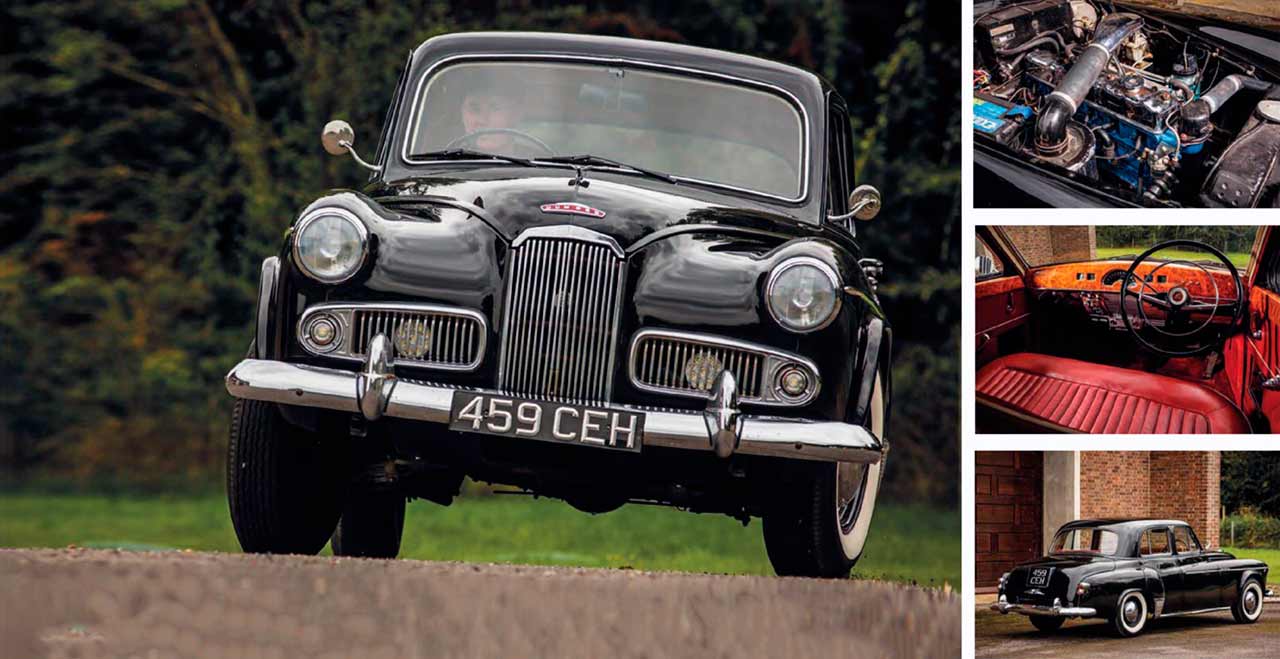
Clockwise, from main: ‘right full rudder!’ – understeer is the order of the day; big ‘six’ affords the Humber near-100mph performance; stately lines; wood and leather cockpit.
TECHNICAL DATA HUMBER SUPER SNIPE IVb
Sold/number built 1952-’1957/17,993 (all)
Construction steel chassis and body
Engine all-iron, ohv 4139cc ‘six’, Stromberg carb;
Power and torque 122bhp @ 3800rpm; 211lb ft @ 1400rpm
Transmission four-speed manual, RWD; o/d from ’55, optional auto from ’56
Suspension: front wishbones, coils rear live axle, semi-elliptics
Steering recirculating ball
Brakes drums
Length 16ft 5in (5004mm)
Width 6ft 1 ½ in (1867mm)
Height 5ft 6in (1676mm)
Weight 4025lb (1825kg)
0-60mph 16.6 secs
Top speed 95mph
Price new £1482 (1952)
Now £10-25,000 (2017)
‘IT BOWLS ALONG WITH AN EFFORTLESS FEEL THAT NONE OF THE OTHERS CAN MATCH’
WOLSELEY 6/80
style=”flat” size=”4″]Ford, Vauxhall and Austin may have signalled the future of British barges, but the Wolseley 6/80 – a proud product of the Nuffield Organisation and one of the first all-new post-war models – seemed to have at least two wheels stuck in the past. Anton Prole’s 1954 6/80, complete with bell, radio and ‘POLICE’ signage, must be one of the last built, just as British housewives were celebrating the end of bacon rationing. It was originally owned by a senior officer from Bristol, and is thought to be the only 6/80 left on the road with genuine Plod connections.
The wooden dashboard and door cappings, plus leather seats and cream instruments, give the 6/80 cabin a pre-war feel that is a ‘cut above’. Beneath its impressively lengthy bonnet, the overhead-camshaft 2.2-litre straight-six engine sounds quite lusty, but it’s fussier than the whisper- quiet Ford and Vauxhall units.
Without actually being in any way pokey, the Wolseley has a sense of purpose about it that is lacking in the other cars. If the gearchange doesn’t achieve the slick standards of the American- influenced vehicles then, with familiarity, you’d still perceive it as being acceptable. The low-geared steering, meanwhile, gives you a mental image of burly traffic cops ‘feeding the wheel’ in the regulation manner.
The Met is thought have had more than 1000 of them, usually as ‘area cars’ with low-ratio back axles to improve acceleration. Contrary to popular belief, they were not tuned for constabulary use, although it was police mechanics who solved the engine’s infamous valve-burning problem. The 6/80’s role with the force gives it a profile in popular culture that is, in some ways, out of all proportion to the 25,000 that were built. Its rounded Packard-meets-Morris Minor styling seems more colonial than Commonwealth, and its image was as stuffy as the Ford and Vauxhall would have been seen as parvenu by the more buttoned-up elements from this decade of National Service and pea-soupers. Yet it is the most fascinating of these cars, the one I was most looking forward to driving and probably the only one I would want to take home. I loved it.
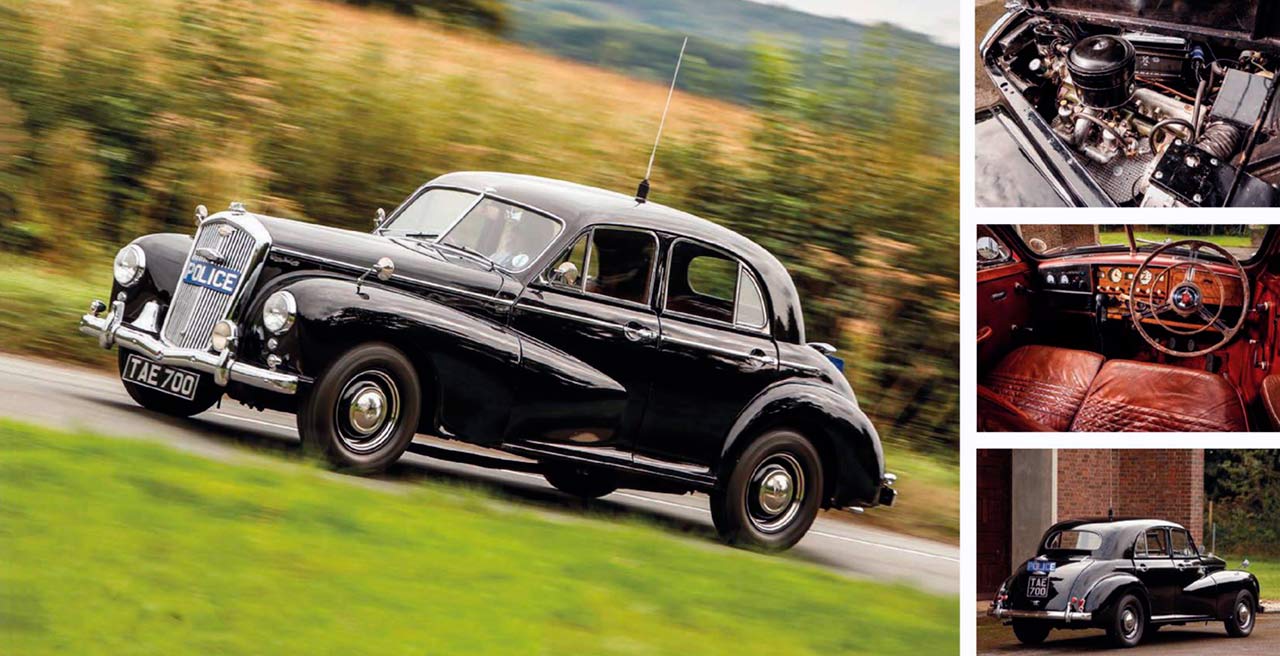
Clockwise, from main: 6/80 is the archetypal 1950s police car; overhead-cam ‘six’; rear styling shared with Morris MO sibling; opulent cabin owes little to austerity.
TECHNICAL DATA WOLSELEY 6/80
Sold/number built 1948-’1954/25,281
Construction steel monocoque
Engine all-iron, ohc 2215cc ‘six’, twin SUs;
Power and torque 72bhp @ 4600rpm; 102lb ft @ 2200rpm
Transmission four-speed manual, RWD
Suspension: front wishbones, torsion bars rear live axle, semi-elliptic leaf springs, Panhard rod
Steering Bishop cam
Brakes drums
Length 14ft 9in (4496mm)
Width 5ft 6in (1676mm)
Height 5ft 3 ½ in (1613mm)
Weight 2690lb (1220kg)
0-60mph 24.4 secs
Top speed 78mph
Price new £767 (1948)
Price now £4-12,000 (2017)
‘THE WOODEN DASH AND LEATHER SEATS GIVE A PRE-WAR FEEL THAT IS A CUT ABOVE’





